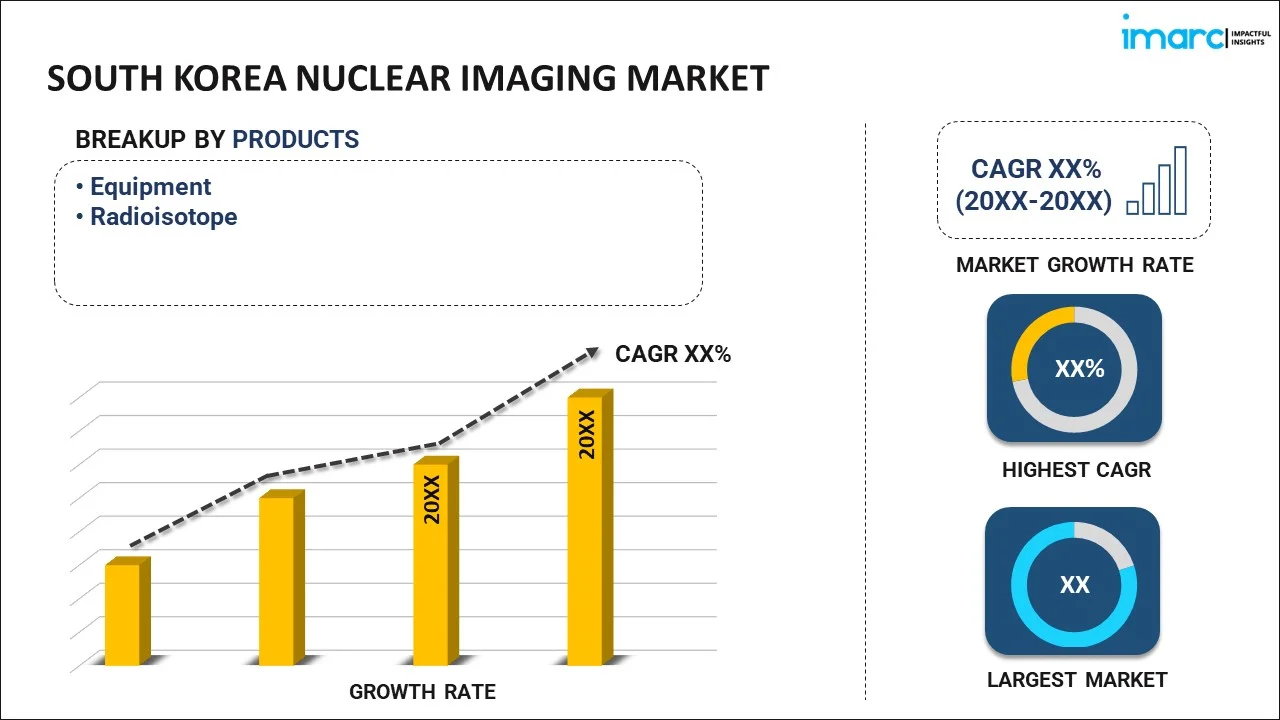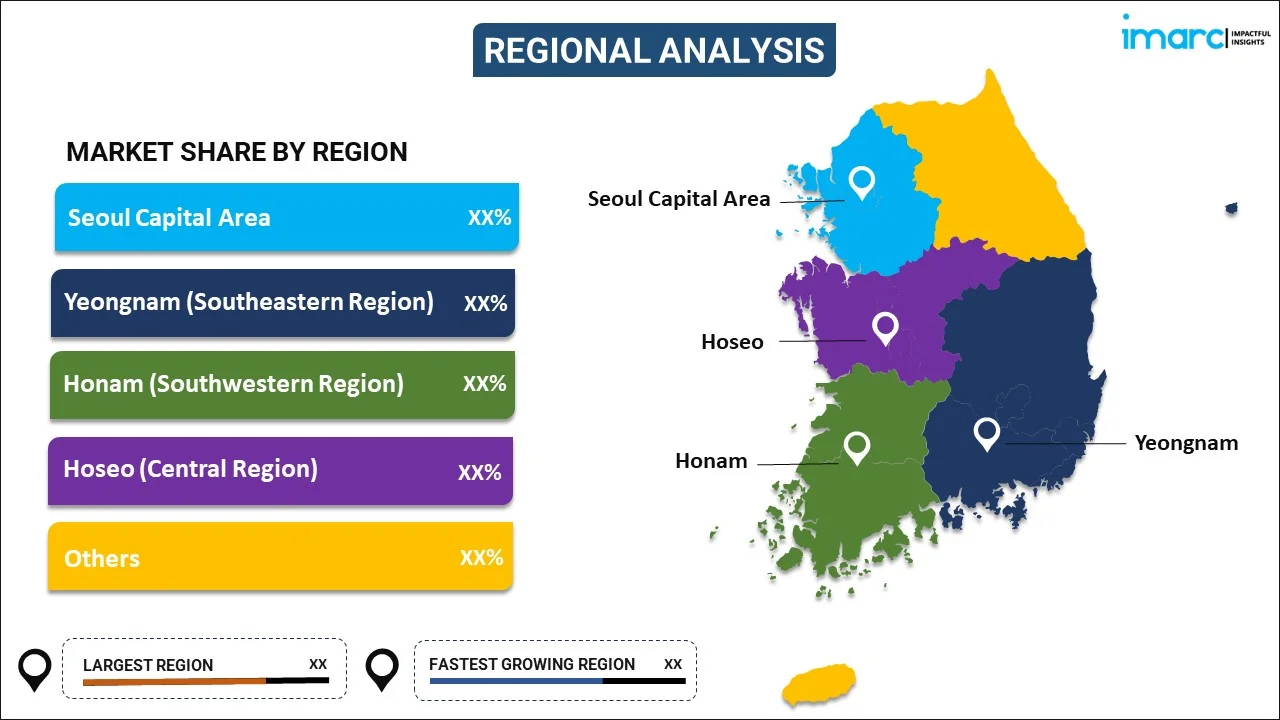
South Korea Nuclear Imaging Market Report by Product (Equipment, Radioisotope), Application (Orthopedics, Thyroid, Cardiology, Oncology, and Others), and Region 2025-2033
Market Overview:
South Korea nuclear imaging market size reached USD 310.0 Million in 2024. Looking forward, IMARC Group expects the market to reach USD 620.0 Million by 2033, exhibiting a growth rate (CAGR) of 7.20% during 2025-2033. The continual discovery of new radiopharmaceuticals, the expanding applications of nuclear imaging, the growing clinical research and development initiatives in nuclear medicine, the rapid integration of nuclear imaging with other imaging modalities, and the escalating awareness and efforts towards cancer screening and early detection initiatives are some of the factors propelling the market.
|
Report Attribute
|
Key Statistics
|
|---|---|
|
Base Year
|
2024
|
|
Forecast Years
|
2025-2033
|
|
Historical Years
|
2019-2024
|
|
Market Size in 2024
|
USD 310.0 Million |
|
Market Forecast in 2033
|
USD 620.0 Million |
| Market Growth Rate 2025-2033 | 7.20% |
Nuclear imaging is a sophisticated medical imaging technique that employs small amounts of radioactive substances, known as radiotracers or radiopharmaceuticals, to visualize and assess the functioning of organs and tissues within the body. Introducing these radiotracers into the patient's body, typically through injection, inhalation, or ingestion. As the radiotracers emit gamma rays, specialized cameras detect and create detailed images, showcasing the distribution of the radiopharmaceuticals. Common nuclear imaging modalities include positron emission tomography (PET) and single-photon emission computed tomography (SPECT). PET scans provide insights into metabolic and molecular processes, offering invaluable information for cancer diagnosis, neurological disorders, and cardiac conditions. On the other hand, SPECT scans focus on organ structure and function and are widely used in cardiology, neurology, and bone imaging. Nuclear imaging plays a pivotal role in early disease detection, staging, and treatment monitoring, offering a non-invasive and comprehensive approach to understanding physiological processes at the molecular level. Despite safety concerns due to the use of radiation, the benefits of precise diagnosis and personalized treatment planning contribute to the continued evolution and adoption of nuclear imaging technologies in modern healthcare.
South Korea Nuclear Imaging Market Trends:
The market in South Korea is majorly driven by the increasing prevalence of chronic diseases, such as cancer and cardiovascular disorders. In line with this, the rising demand for precise diagnostic tools for early detection and accurate staging is significantly contributing to the market growth. Nuclear imaging, particularly PET and SPECT scans, provides unparalleled insights into diseases' molecular and functional aspects, revolutionizing diagnostics and treatment planning. Moreover, the rising aging population is positively influencing market growth, as elderly individuals are more prone to conditions necessitating advanced imaging for effective management. Technological advancements in nuclear imaging systems, including enhanced resolution and sensitivity, further fuel market expansion, allowing for more accurate and detailed scans. Besides, the rapid integration of artificial intelligence (AI) and machine learning in image analysis adds another layer of sophistication, improving diagnostic accuracy and efficiency. Additionally, the rising adoption of nuclear medicine for therapeutic applications, such as targeted radionuclide therapies, broadens the scope of nuclear imaging beyond diagnostics, fostering market growth. Collaborations between healthcare institutions and research organizations drive innovation in radiopharmaceutical development, expanding the repertoire of applications for nuclear imaging. The global emphasis on personalized medicine and the need for non-invasive, comprehensive imaging modalities position nuclear imaging at the forefront of modern healthcare. This contributes to its sustained market growth as an indispensable tool for precise and early disease management.
South Korea Nuclear Imaging Market Segmentation:
IMARC Group provides an analysis of the key trends in each segment of the market, along with forecasts at the country level for 2025-2033. Our report has categorized the market based on product and application.
Product Insights:

- Equipment
- Single Photon Emission Computed Tomography (SPECT)
- Positron-Emission Tomography (PET)
- Radioisotope
- SPECT Radioisotopes
- PET Radioisotopes
The report has provided a detailed breakup and analysis of the market based on the product. This includes equipment (single photon emission computed tomography (SPECT) and positron-emission tomography (PET)) and radioisotope (SPECT radioisotopes and PET radioisotopes).
Application Insights:
- Orthopedics
- Thyroid
- Cardiology
- Oncology
- Others
A detailed breakup and analysis of the market based on the application have also been provided in the report. This includes orthopedics, thyroid, cardiology, oncology, and others.
Regional Insights:

- Seoul Capital Area
- Yeongnam (Southeastern Region)
- Honam (Southwestern Region)
- Hoseo (Central Region)
- Others
The report has also provided a comprehensive analysis of all the major regional markets, which include Seoul Capital Area, Yeongnam (Southeastern Region), Honam (Southwestern Region), Hoseo (Central Region), and others.
Competitive Landscape:
The market research report has also provided a comprehensive analysis of the competitive landscape in the market. Competitive analysis such as market structure, key player positioning, top winning strategies, competitive dashboard, and company evaluation quadrant has been covered in the report. Also, detailed profiles of all major companies have been provided.
South Korea Nuclear Imaging Market Report Coverage:
| Report Features | Details |
|---|---|
| Base Year of the Analysis | 2024 |
| Historical Period | 2019-2024 |
| Forecast Period | 2025-2033 |
| Units | Million USD |
| Scope of the Report | Exploration of Historical and Forecast Trends, Industry Catalysts and Challenges, Segment-Wise Historical and Predictive Market Assessment:
|
| Products Covered |
|
| Applications Covered | Orthopedics, Thyroid, Cardiology, Oncology, Others |
| Regions Covered | Seoul Capital Area, Yeongnam (Southeastern Region), Honam (Southwestern Region), Hoseo (Central Region), Others |
| Customization Scope | 10% Free Customization |
| Post-Sale Analyst Support | 10-12 Weeks |
| Delivery Format | PDF and Excel through Email (We can also provide the editable version of the report in PPT/Word format on special request) |
Key Questions Answered in This Report:
- How has the South Korea nuclear imaging market performed so far and how will it perform in the coming years?
- What has been the impact of COVID-19 on the South Korea nuclear imaging market?
- What is the breakup of the South Korea nuclear imaging market on the basis of product?
- What is the breakup of the South Korea nuclear imaging market on the basis of application?
- What are the various stages in the value chain of the South Korea nuclear imaging market?
- What are the key driving factors and challenges in the South Korea nuclear imaging?
- What is the structure of the South Korea nuclear imaging market and who are the key players?
- What is the degree of competition in the South Korea nuclear imaging market?
Key Benefits for Stakeholders:
- IMARC’s industry report offers a comprehensive quantitative analysis of various market segments, historical and current market trends, market forecasts, and dynamics of the South Korea nuclear imaging market from 2019-2033.
- The research report provides the latest information on the market drivers, challenges, and opportunities in the South Korea nuclear imaging market.
- Porter's five forces analysis assist stakeholders in assessing the impact of new entrants, competitive rivalry, supplier power, buyer power, and the threat of substitution. It helps stakeholders to analyze the level of competition within the South Korea nuclear imaging industry and its attractiveness.
- Competitive landscape allows stakeholders to understand their competitive environment and provides an insight into the current positions of key players in the market.
Need more help?
- Speak to our experienced analysts for insights on the current market scenarios.
- Include additional segments and countries to customize the report as per your requirement.
- Gain an unparalleled competitive advantage in your domain by understanding how to utilize the report and positively impacting your operations and revenue.
- For further assistance, please connect with our analysts.
 Inquire Before Buying
Inquire Before Buying
 Speak to an Analyst
Speak to an Analyst
 Request Brochure
Request Brochure
 Request Customization
Request Customization




.webp)




.webp)












